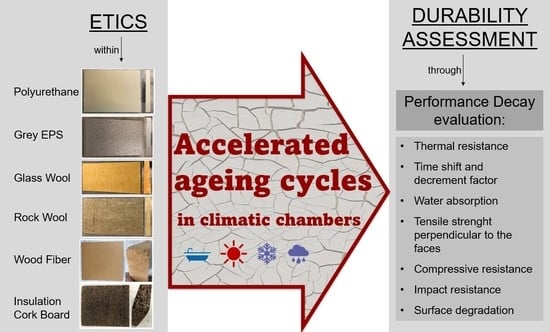Durability Assessment of ETICS: Comparative Evaluation of Different Insulating Materials
Abstract
:1. Introduction
1.1. Building Sector and Energy Efficiency Developments
1.2. ETICS
- Adhesive;
- Insulation products;
- Mechanical-fixing devices;
- Rendering systems, typically consisting of a base coat, reinforcement—glass fiber, and a finishing coat/decorative coat;
- Secondary materials (any supplementary component/product used to form joints or to achieve continuity).
1.3. Research Issue
- The definition of users’ needs, involving technological requirements within the stress context (type and intensity of the agents). The target of this section is to define the requirements of building components and related required performance;
- The identification of degradation mechanisms and effects, and the choice of measurement criteria for functional and performance characteristics technology;
- Exposure and measurement. This is the phase in which ageing tests are performed, both natural (long-term exposure) and accelerated (short-term exposure), and in which the effects of the agents on the building components are measured (degradation);
- The analysis and interpretation of results. Analyzing the results obtained through experimentation (in terms of performance over time), the service life of a component, under certain stress conditions, is assumed.
2. Materials and Methods
2.1. Insulating Materials
- Polyurethane (PU);
- Grey expanded polystyrene (EPS);
- Glass mineral wool (GW, named according to EN code 13162);
- Rock mineral wool (MW, named according to EN code 13162);
- Cork (ICB, insulation cork board, according to the reference code EN 13170);
- Wood fiberboard (WF).
- Support of wooden OSB (oriented strand board; thickness = 2 mm) and outdoor plasterboard panel (thickness = 12.5 mm) instead of masonry wall, because the aim of the research is focused on the interaction between an ETICS and environmental loads, and not on the back support, which does not have any kind of influence on the durability of the system;
- Skim-coating adhesive (a mineral adhesive/skim coat in powder form made of unsaponifiable resins), high-resistance Portland cement, and selected sands with a maximum particle size of 0.6 mm;
- Thermal insulating material with different widths as a consequence of the different conductivities, as specified in Table 1, in which the system name refers to commercial name of the company which has provided materials; the target value of thermal transmittance has been chosen in compliance with Italian law requirements (D.M. 26 June 2015), considering the hypothesis of a double-brick wall with internal cavity;
- Base coat with embedded reinforcing fiberglass mesh; the base coat material is the same skim-coating adhesive;
- Finishing coat. A coating based on acrylic resins in dispersion within additives that facilitate application and formation of a film, as well as marble granules and quartz sand with controlled absorption—max particle size 1.2 mm.
2.2. Pre-Designing Ageing Cycles
- Summer and winter thermal shocks;
- Freeze–thaw cycles;
- Driving rain;
- Cyclic variations in temperature and relative humidity.
2.3. EAD 040083 Procedure for Investigation of ETICS Durability
2.4. Designed Accelerated Ageing Cycles
- A Hygrothermal behavior test which includes heat–rain cycles and heat–cold cycles, Section 2.2.6 of EAD 040083: water tightness of the ETICS: hygrothermal behavior);
- Freeze and thaw behavior test, Section 2.2.5.1 of EAD 040083.
- A total of 80 heat–rain cycles. Each cycle takes 6 h and consists firstly in heating to 80 °C (rising for 1 h) and maintaining at (80 + 5) °C for 2 h (total of 3 h), then spraying for 1 h with 1.5 ± 0.5 L/m2 min amount of water and water temperature at 15 ± 5 °C, and thirdly leaving for 2 h for drainage at 20 ± 5 °C;
- A total of 7 heat–cold cycles. Each cycle lasts 24 h, comprising an initial exposure of 8 h to −10 ± 2 °C (fall for 2 h), then 9 h to 70 ± 2 °C (rise for 1 h) and maximum 30% RH, and finally exposure of 7 h to −10 ± 2 °C (fall for 2 h);
- A total of 15 freeze–thaw cycles. Each cycle lasts 24 h, comprising an initial exposure for 8 h to water at 23 ± 4 °C by immersion of the specimens, with the skin submerged in a water bath according to the method described in EAD 040083 Section 2.2.7 [32], then, freezing to −20 ± 5 °C for 14 h, and a final insertion in the stove at +50 °C for 2 h.
3. Decay Assessment
- Thermal resistance;
- Time shift;
- Decrement factor;
- Water absorption;
- Tensile strength perpendicular to faces;
- Compressive strength;
- Impact resistance;
- Surface degradation.
3.1. Thermal Resistance/Transmittance
3.2. Time Shift and Decrement Factor
3.3. Water Absorption
3.4. Tensile Strength Perpendicular to Faces
3.5. Compressive Strength
3.6. Impact Resistance
3.7. Surface Degradation
4. Results and Discussion
- (1)
- Realization of ETICS samples by varying the insulating material among grey EPS, PU, GW, MW, ICB, and WF, without varying the other layers;
- (2)
- Collection of data related to an in-use ETICS with an adequate population, with the same stratigraphy as the sampled ETICS; characterization of the in-use ETICS solutions according to:
- Stratigraphy;
- Age of realization;
- Performance degree (blistering grade through photographic degradation survey according to ISO code 4628-2);
- (3)
- Execution of accelerated ageing test on the samples in climatic chambers, measuring the state of decay after a fixed number of cycles;
- (4)
- Statistical correlation between performance decay on the samples and on the in-use solutions, and obtainment of the mean re-scaling factor;
- (5)
- Evaluation of the decay before the test, and after number of cycles that have been found out to correspond to n years. The decay is measured according to the seven aforementioned tests. The first results, listed in the paragraphs 4.1, 4.2, and 4.3, record thermal performances and the water absorption test. With regards to the last performances (the mechanical ones), they will be analyzed hereafter, since they are destructive tests and they are not repeatable;
- (6)
- Realization of the performance–time curve for each of the solutions represented by the six samples.
4.1. Thermal Resistance/Transmittance Assessment
4.2. Time Shift and Decrement Factor Assessment
4.3. Water Absorption Assessments
5. Conclusions and Further Developments
- A comparison between all the most common and best-performing materials used as thermal insulation components in vertical envelopes of ETICSs, especially in regard to their durability in order to predict and quantify service life, and correctly plan maintenance with the future objective of a life-cycle assessment;
- An investigation on the influence of the thermal insulation panel in ETICSs, rather than on the external renders (other studies have focused on the variable durability of the renders);
- An investigation on ETICS durability through service life estimation by mean statistic value of the re-scaling factor, by relating the measured state of decay of the accelerated aged samples to the naturally aged components of real-building cases;
- It is crucial to point out that the aim of the research consists in accelerated ageing cycles resembling real-time building cases (as the objective is to predict service life in given conditions), and to assess performance decay—and its evolution—over time (ISO code 15686-7-based [49]).
Author Contributions
Funding
Institutional Review Board Statement
Informed Consent Statement
Data Availability Statement
Conflicts of Interest
References
- Global Status Report for Buildings and Construction. Towards a Zero-Emission, Efficient and Resilient Buildings and Construction Sector. Available online: https://www.unenvironment.org/resources/publication/2019-global-status-report-buildings-and-construction-sector (accessed on 3 January 2021).
- World Green Building Council. New Report: The Building and Construction Sector Can Reach Net Zero Carbon Emissions by 2050. World GBC 2019. Available online: https://www.worldgbc.org/news-media/WorldGBC-embodied-carbon-report-published (accessed on 28 December 2020).
- European Commission. Energy Performance of Buildings Directive. 2020. Available online: https://ec.europa.eu/energy/topics/energy-efficiency/energy-efficient-buildings/energy-performance-buildings-directive_en#:~:text=Buildings%20are%20responsible%20for%20approximately,building%20stock%20is%20energy%20inefficient (accessed on 28 December 2020).
- Bartosz, M.; Marta, M. Influence of rendering type on the environmental characteristics of expanded polystyrene-based external thermal insulation composite system. Sustainability 2020, 10, 47. [Google Scholar]
- Building Performance Institute Europe. 97% of Buildings in the Eu Need to Be Upgraded. Available online: https://www.bpie.eu/wp-content/uploads/2017/12/State-of-the-building-stock-briefing_Dic6.pdf (accessed on 17 April 2021).
- Global Energy Assessment Writing Team. Global Energy Assessment: Toward Sustainable Future; Cambridge University Press: Cambridge, UK, 2012; pp. 649–760. [Google Scholar]
- Hens, H.; Carmeliet, J. Performance Prediction for Masonry Walls with EIFS Using Calculation Procedures and Laboratory Testing. J. Therm. Env. Bldg. Sci. 2002, 25, 2. [Google Scholar] [CrossRef]
- European Assessment External Thermal Composite System (EAE); About ETICS. Available online: https://www.ea-etics.eu/etics/about-etics/ (accessed on 28 December 2020).
- Sala, S.; Mathieux, F.; Pant, R. Life Cycle Assessment and Sustainability: Supporting Decision Making by Business and Policy. In Sustainability Assessment of Renewables-Based Products: Methods and Case Studies; Dewulf, J., De Meester, S., Alvarenga, R., Eds.; John Wiley & Sons, Ltd.: Hoboken, NJ, USA, 2016; Volume 13, pp. 201–214. [Google Scholar]
- ISO 15686-2Code; Building and Constructed Assets–Service Life Planning: Service Life Prediction Procedures. International Organization for Standardization (acronym ISO): Genève, Switzerland, 2001.
- Samuelson, I.; Jansson, A. Putsade Regelväggar. [ETICS on Framework Walls], SP Rapport 2009:16; SP Technical Research Institute of Sweden: Borås, Sweden, 2009. [Google Scholar]
- Lisø, K.R. Building Envelope Performance in Harsh Climates: Methods for Geographically Dependent Design. Ph.D. Thesis, Norwegian University of Science and Technology, Trondheim, Norway, 2006. [Google Scholar]
- Lisø, K.R.; Kvande, T.; Thue, J.V. Learning from Experience–An Analysis of Process Induced Building Defects in Norway. In Proceedings of the 3rd International Building Physics Conference, Montreal, QC, Canada, 27–31 August 2006. [Google Scholar]
- Kvande, T.; Bakken, N.; Bergheim, E.; Vincent, J. The Durability of ETICS with Rendering in Norway–Experimental and Field Investigations. Buildings 2018, 8, 93. [Google Scholar] [CrossRef] [Green Version]
- Amaro, B.; de Brito, J.; Flores-Colen, I. Statistical survey of the pathology, diagnosis and rehabilitation of ETICS in walls. J. Civ. Eng. Manag. 2012, 20, 511–526. [Google Scholar] [CrossRef] [Green Version]
- De Freitas, S.; Vasco, P. Cracks on ETICS along thermal insulation joints: Case study and a pathology catalogue. Struct. Surv. 2016, 34, 57–72. [Google Scholar] [CrossRef]
- Jelle, B.P. The Role of Accelerated Climate Ageing of Building Materials, Components and Structures in the Laboratory. In Proceedings of the 7th Nordic conference on Construction Economics and Organisation, Trondheim, Norway, 12–14 June 2013. [Google Scholar]
- Jelle, B.P. Accelerated climate ageing of building Materials, Components and Structures in the Laboratory. Mater. Sci. 2011, 47, 6475–6496. [Google Scholar] [CrossRef] [Green Version]
- Bochen, J. Durability assessment of durability materials exposed to atmosphere agents by testing in simulated environment. ACEE 2013, 6, 17–25. [Google Scholar]
- Bochen, J.; Gil, S.; Szwabowski, J. Influence of ageing process on porosity changes of the external plasters. Cem. Concr. Compos. 2005, 27, 769–775. [Google Scholar] [CrossRef]
- Bochen, J.; Gil, S. Study on the microstructure of thin-layer facade plasters of thermal insulating system during artificial weathering. Constr. Build. Mater. 2009, 23, 2559–2566. [Google Scholar] [CrossRef]
- Bochen, J. Properties of pore structure of thin-layer external plasters under ageing in simulated environment. Constr. Build. Mater. 2009, 23, 2958–2963. [Google Scholar] [CrossRef]
- Brandt, E. Building Materials and Components in Vertical Position: Exposure to Accelerated Climatic Strains; Nordest Espoo: Alborg, Finland, 2000. [Google Scholar]
- Norvaišienė, R.; Burlingis, A.; Stankevičius, V. Durability Tests on Painted Facade Rendering by Accelerated Ageing. Mater. Sci. 2010, 16, 80–85. [Google Scholar]
- Daniotti, B.; Iacono, P. Evaluating the Service Life of External Walls: A Comparison between Long-Term and Short-Term Exposure. In Proceedings of the 10th International Conference on Durability of Building Materials and Components, Lyon, France, 17–20 April 2005. [Google Scholar]
- Daniotti, B.; Spagnolo, S.L.; Paolini, R. Climatic Data Analysis to Define Accelerated Ageing for Reference Service Life Evaluation. In Proceedings of the 11th International Conference on Durability of Building Materials and Components, Istanbul, Turkey, 11–14 May 2008. [Google Scholar]
- Daniotti, B.; Lupica Spagnolo, S.; Paolini, R. Procedures for Reference Service Life Assessment of Building Components: Advances in research. In Proceedings of the International Conference on Construction & Building Research, Madrid, Spain, 14–26 June 2009. [Google Scholar]
- ETAG004; Guidelines for European Technical Approval of External Thermal Insulation Composite Systems (ETICS) with Rendering. European Organisation for Technical Approvals: Brussels, Belgium, 2014.
- Daniotti, B.; Paolini, R.; Re Cecconi, F. Effects of Ageing and Moisture on Thermal Performance of ETICS Cladding. In Durability of Building Materials and Components, 3rd ed.; Building Pathology and Rehabilitation; de Freitas, V.P., Delgado, J.M.P.Q., Eds.; Springer: Berlin, Germany, 2009; Volume 3, pp. 121–171. [Google Scholar]
- ISO 4628 Standard; Paints and Varnishes–Evaluation of Degradation of Coatings–Designation of Quantity and Size of Defects, and of Intensity of Uniform Changes in Appearance. International Organization for Standardization (acronym ISO): Genève, Switzerland, 2016.
- UNI/TR 11715 Code; Thermal Insulation Products for Buildings–Design and In-Situ Installation of External Thermal Insulation Composite Systems with Renders (ETICS). Italian National Unification Body (acronym UNI): Milan, Italy, 2018.
- EAD 040083; External Thermal Insulation Composite Systems (ETICS) with Renderings. European Organisation for Technical Approvals: Brussels, Belgium, 2019.
- Andrady, A.L.; Pandey, K.K.; Heikkilä, A.M. Interactive effects of solar UV radiation and climate change on material damage. Photochem. Photobiol. Sci. 2019, 18, 804–825. [Google Scholar] [CrossRef] [PubMed]
- European Regulation n° 305/2011: Construction Product Regulation; European parliament: Bruxelles, Belgium, 2011.
- EAD 040427 Code; Kits for External Thermal Insulation Composite System (ETICS) with Mortar as Thermal Insulation Product and Renderings or Discontinuous Cladding as Exterior Skin. European Organization for Technical Approvals: Brussels, Belgium, 2019.
- UNI EN 12667; Prestazione Termica dei Materiali e dei Prodotti per L’edilizia. Determinazione Della Resistenza Termica Con il Metodo della Piastra Calda con Anello di Guardia e con il Metodo del Termoflussimetro. Italian National Unification Body (acronym UNI): Milan, Italy, 2002.
- ISO 6946; Building Components and Building Elements–Thermal Resistance and Thermal Transmittance–Calculation Methods. International Organization for Standardization (acronym ISO): Genève, Switzerland, 2017.
- UNI 10349 Standard; Riscaldamento e Raffrescamento Degli Edifici–Dati Climatici. Italian National Unification Body (acronym UNI): Milan, Italy, 2016.
- EN 1609 Standard; Thermal Insulating Products for Building Applications–Determination of Dimensional Short Term Water Absorption by Partial Immersion. European Committee for Standardization (CEN): Bruxelles, Belgium, 2013.
- EN 1607 Standard; Thermal Insulating Products for Building Applications–Determination of Tensile Strength Perpendicular to Faces. European Committee for Standardization (CEN): Bruxelles, Belgium, 2013.
- EN 826 Standard; Thermal Insulating Products for Building Applications–Determination of Compression Behaviour. European Committee for Standardization (CEN): Bruxelles, Belgium, 2013.
- ISO 7892 Standard; Vertical Building Elements–Impact Resistance Tests–Impact Bodies and General Test Procedures. International Organization for Standardization (acronym ISO): Genève, Switzerland, 1988.
- EN 13172; Thermal Insulation Products. Evaluation of Conformity. European Committee for Standardization (CEN): Bruxelles, Belgium, 2012.
- Glicksman, L.R.; Stewart, J. The Measurement of the Morphology of Closed Cell Foams Which Control the Overall Thermal Conductivity. In Proceedings of the Third Conference Insulation Materials: Testing and Applications, Quebec City, QC, Canada, 15–17 May 1997. [Google Scholar]
- EN 13165; Thermal Insulation Products for Buildings, Factory Made Rigid Polyurethane Foam (PU) Products. Specification European Committee for Standardization (CEN): Bruxelles, Belgium, 2012.
- Albrecht, W. Change over Time in the thermal conductivity of ten-year-old PUR rigid foam boards with diffusion-open facings. Cell. Polym. 2004, 23, 161–172. [Google Scholar] [CrossRef]
- Stefani, A. Stabilità nel Tempo delle Prestazioni Isolanti; Poliuretano Luglio 2003; Associazione Nazionale Poliuretano Espanso rigido (ANPE): Vicenza, Italy, 2003; pp. 8–10. [Google Scholar]
- Nicolella, M.; Landolfi, R.; Pino, A.; Scognamillo, C. Comparative Evaluations of Sustainability, Durability and Resilience of External Envelopes for Environmentally Efficient Buildings. In Proceedings of the Sustainable Built Environment Conference (SBE19), Milan, Italy, 4–5 September 2019. [Google Scholar]
- ISO 15686-7 Code; Building and Constructed Assets–Service Life Planning: Performance Evaluation for Feedback of Service Life Data from Practice. International Organization for Standardization (acronym ISO): Genève, Switzerland, 2001.
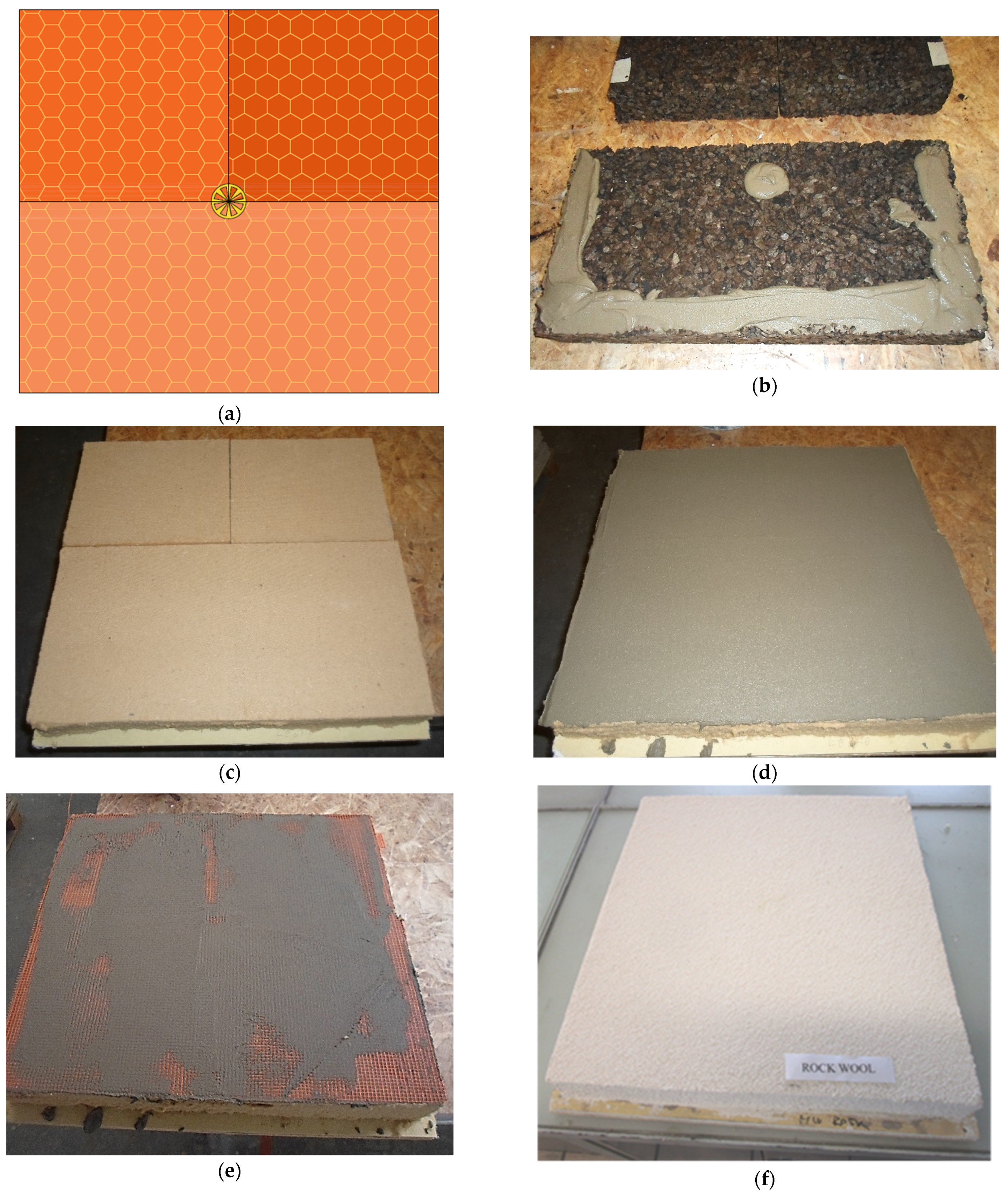
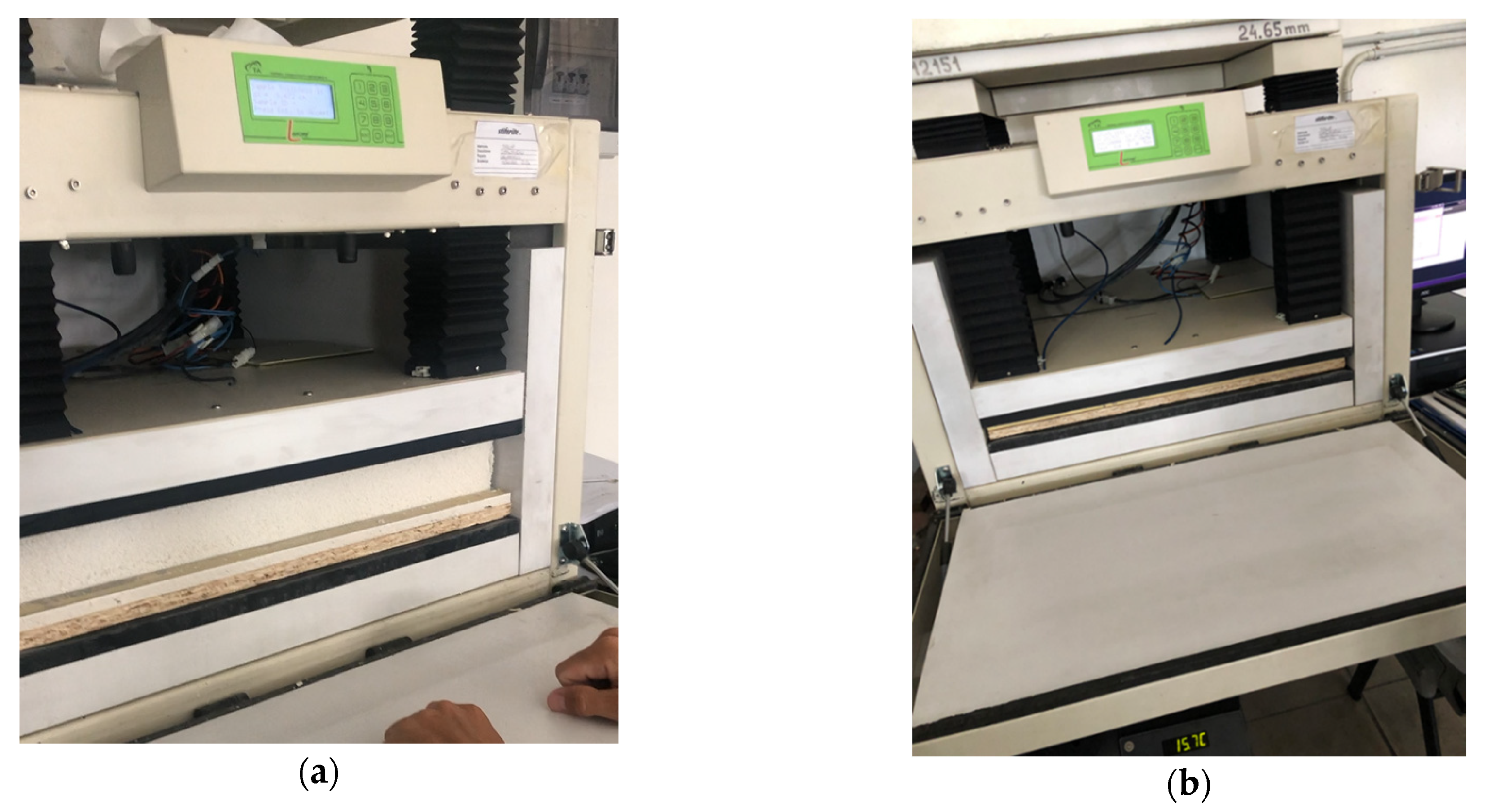
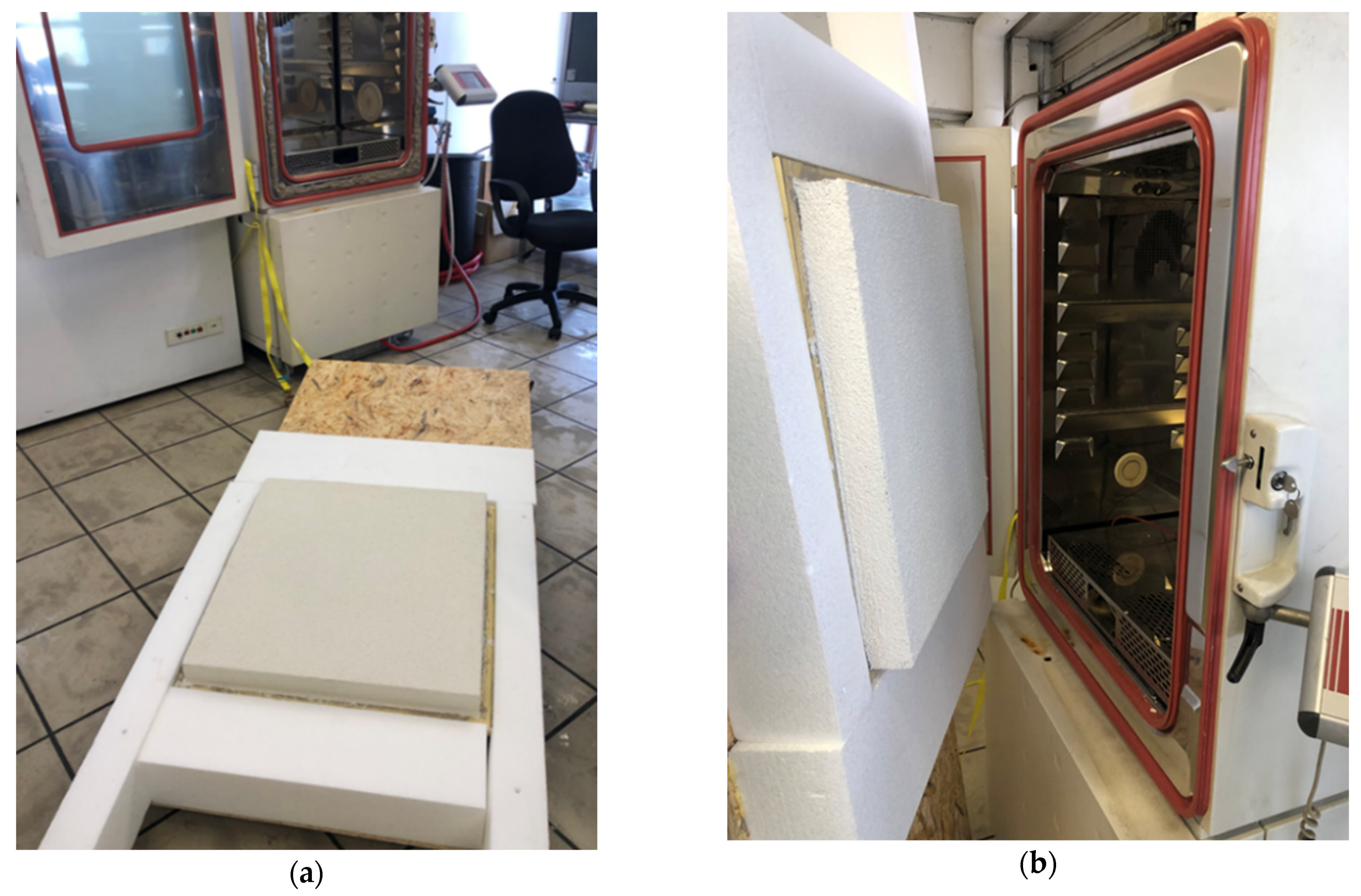
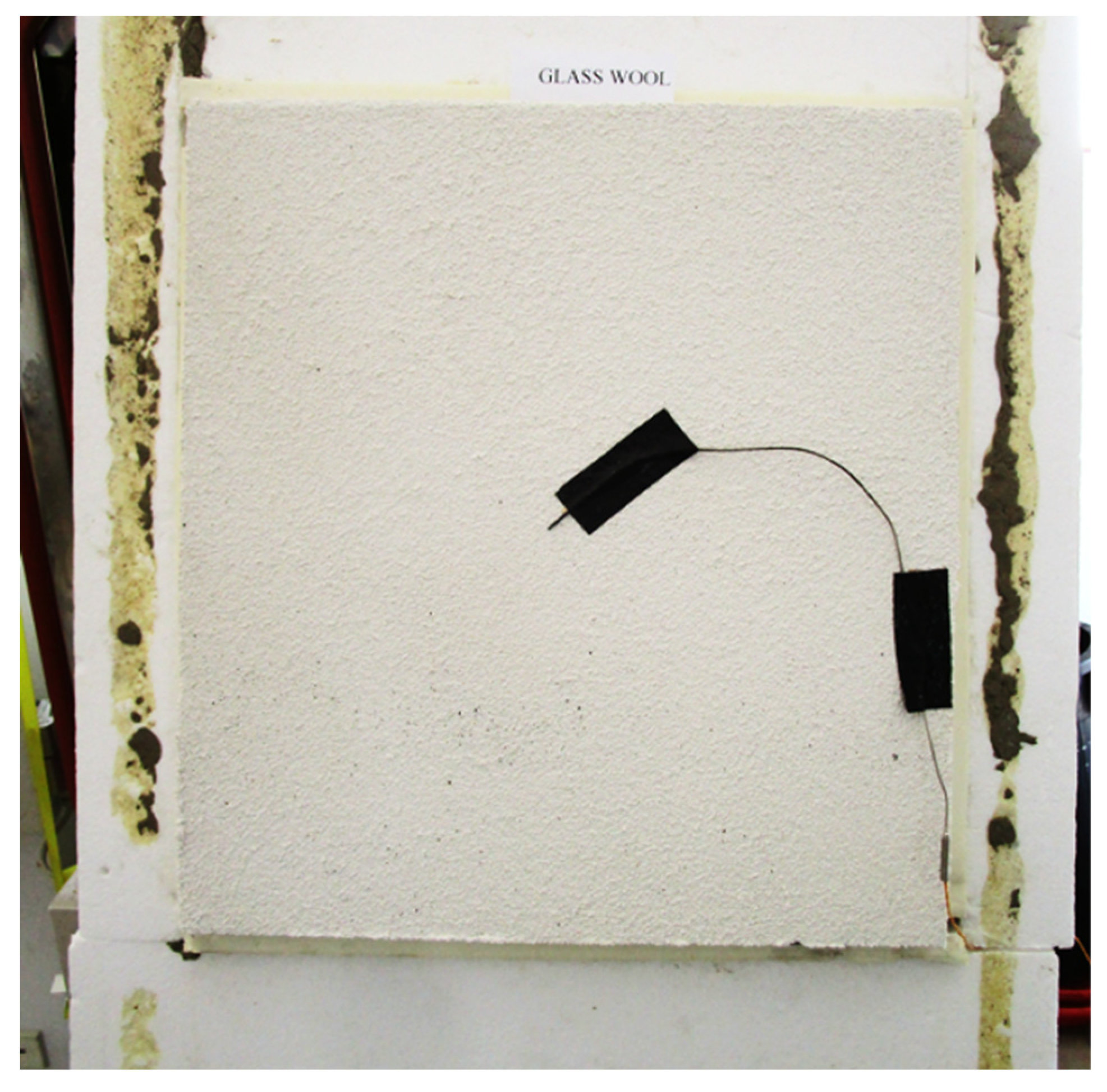
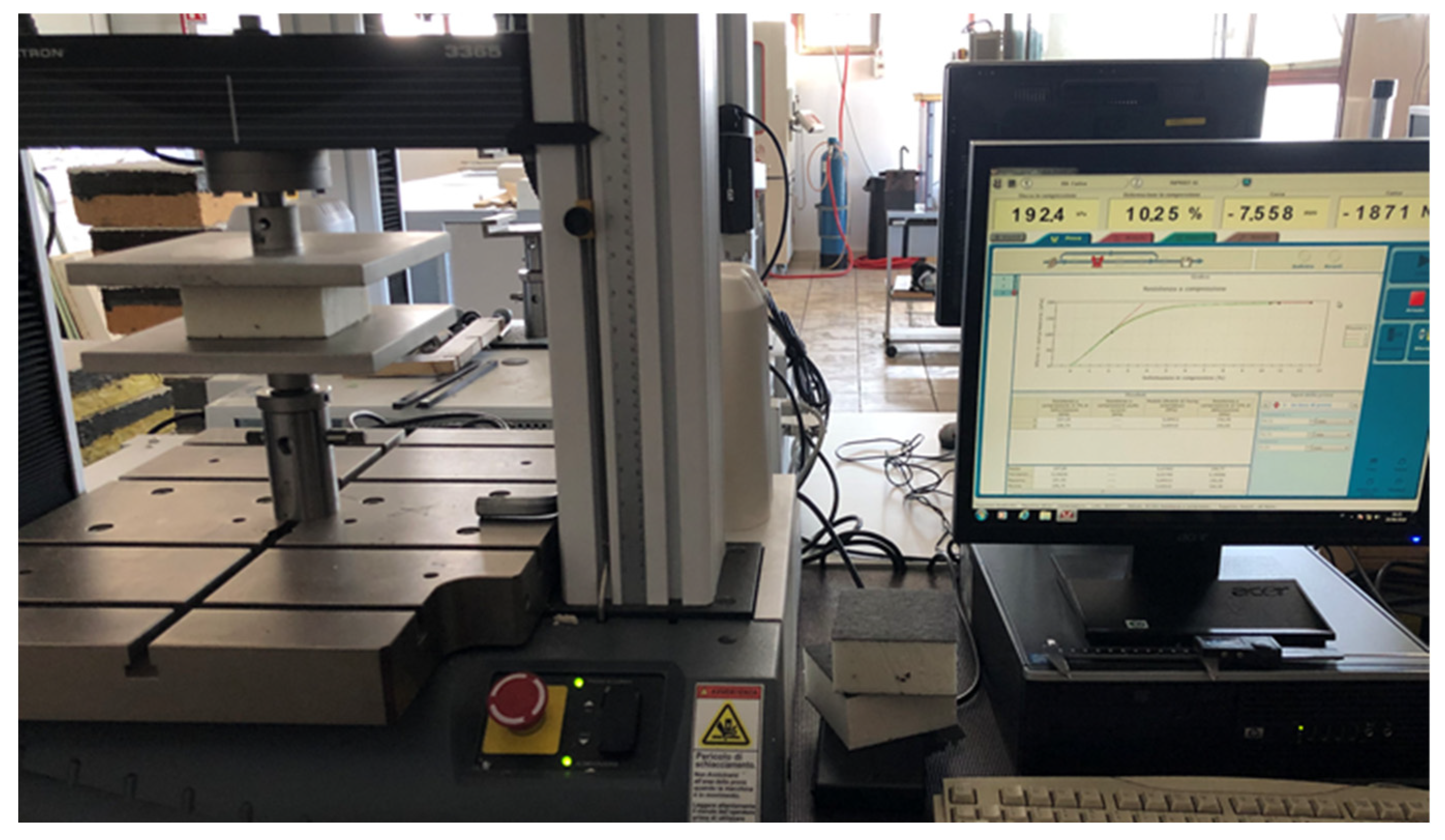
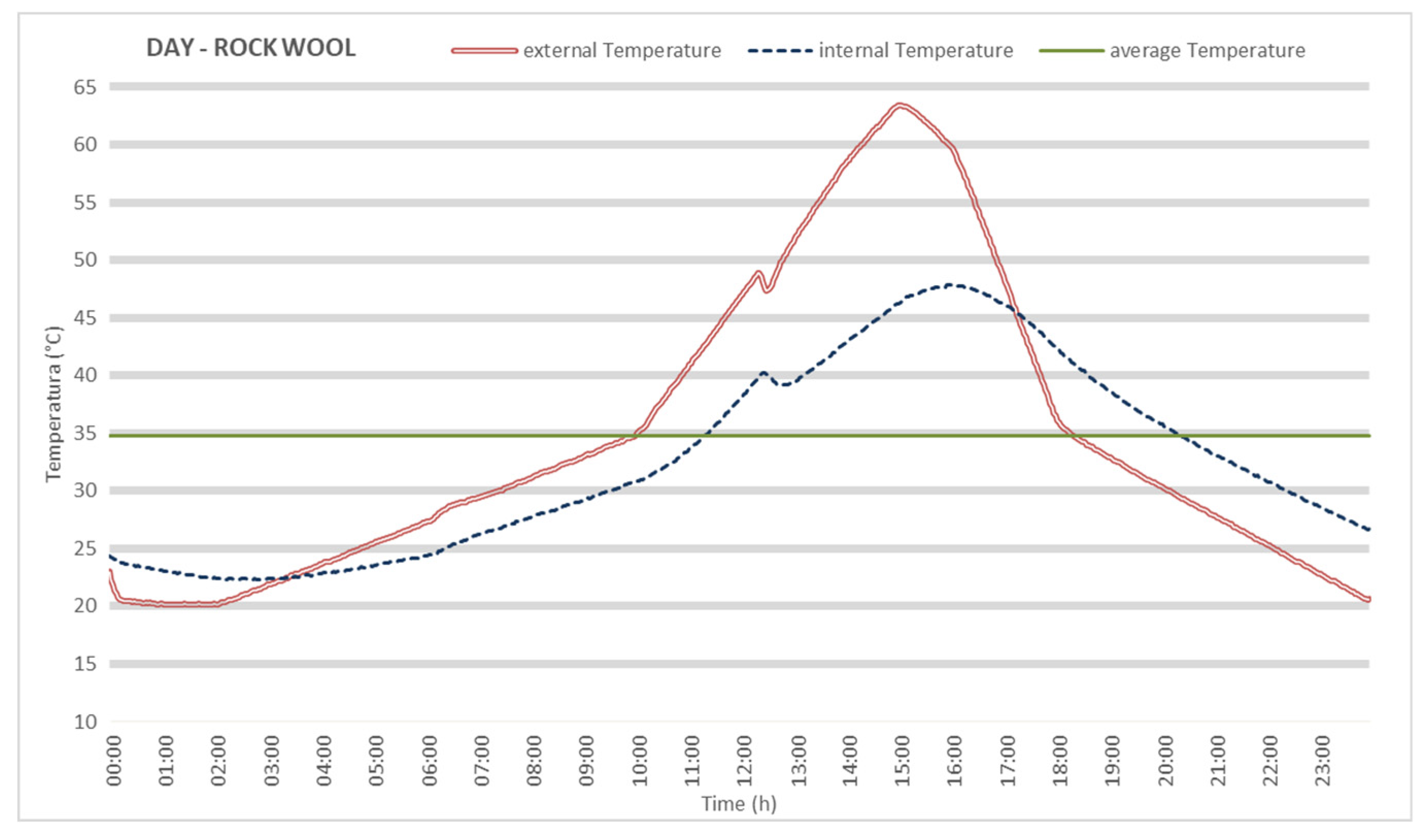
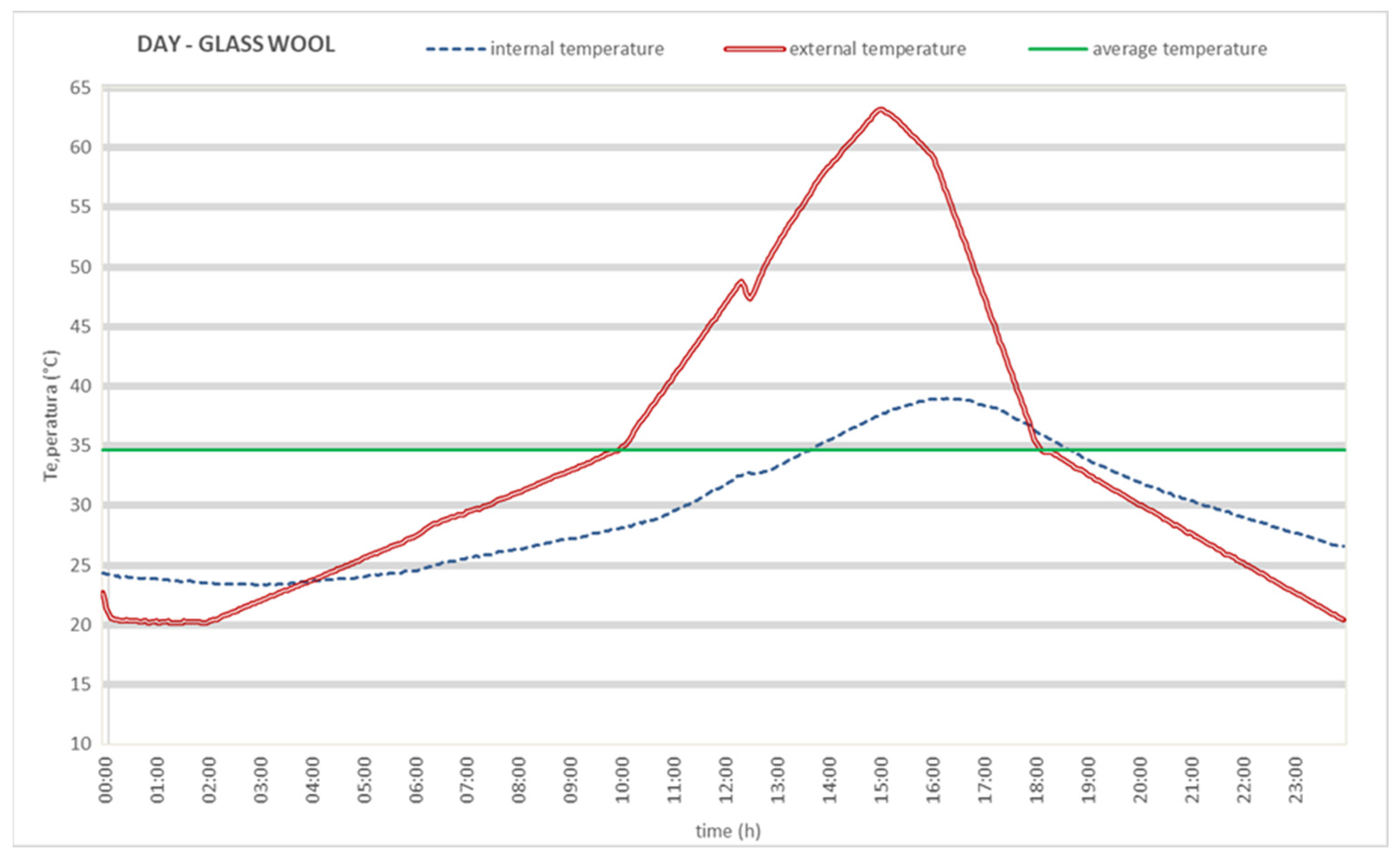
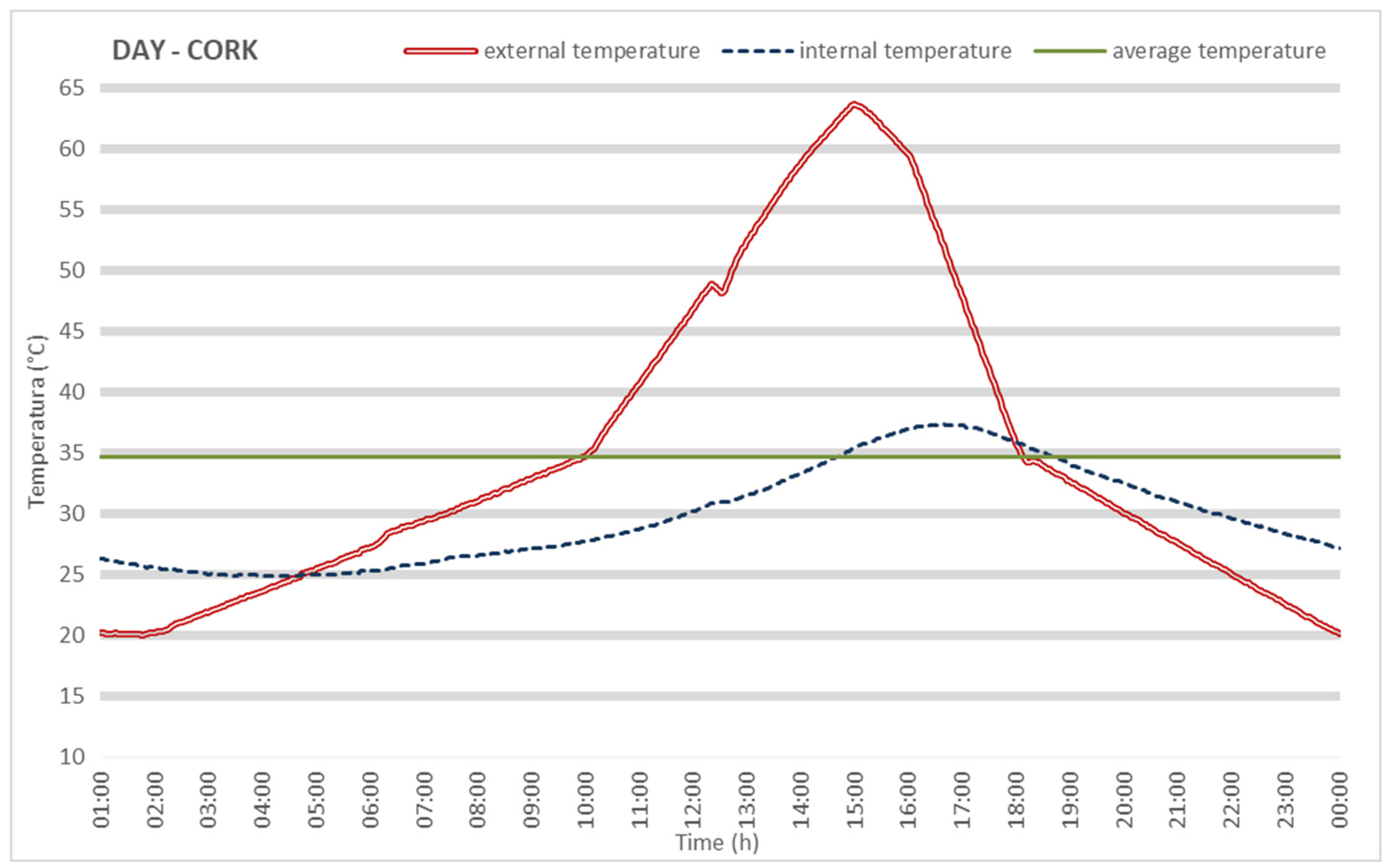
| Insulating Materials | Commercial ETICS Name | Insulating Panel | Whole ETICS | ||
|---|---|---|---|---|---|
| D (mm) | λD (W/mK) | Uc (W/m2K) | Rc (m2K/W) | ||
| PU | Termok8 Slim | 50 | 0.028 | 0.51 | 1.97 |
| Grey EPS | Termok8 Modulare Biostone | 60 | 0.031 | 0.47 | 2.12 |
| MW | Termok8 Minerale LR | 60 | 0.036 | 0.53 | 1.90 |
| GW | Termok8 Minerale LV | 60 | 0.034 | 0.51 | 1.95 |
| ICB | Termok8 Minerale SU | 80 | 0.040 | 0.46 | 2.18 |
| WF | Termok8 Wood | 80 | 0.043 | 0.54 | 2.04 |
| Materials | ρm(kg/m3) | Cpm(J/kg°K) | μd | WSd(kg/m2) |
|---|---|---|---|---|
| PU | 34.03 | 1464 | 56 | <0.2 |
| EPS | 10.35 | 1340 | 30–70 | ≤0.5 |
| MW | 89.01 | 1030 | 1 | ≤1 |
| GW | 71.66 | 1030 | 1 | ≤1 |
| ICB | 97.41 | 2100 | not declared | not declared |
| WF | 144.08 | 2250 | 3 | 1 |
| Base coat | 1550 ± 50 | 5–20 | Classe W2 (C ≤ 0.2 kg/m2min0.5) 3 | |
| Finishing coat | 1800 ± 100 | Classe V2 media 2 | Classe W2 media 4 |
| Cycle Tipology | Cycle Number | Phase/ Insertion in: | Phase Dt (h) | Cycle Dt (h) | T (°C) | RH (%) |
|---|---|---|---|---|---|---|
| Heat–Rain | 80 | Heater | 3 | 80 | 50 | |
| Spry | 1 | 15 ± 5 | 100 | |||
| Drainage | 2 | 6 | 15 ± 5 | 100–50 | ||
| Heat–Cold | 7 | Climatic Chamber | 8 | 70 | 30 | |
| Climatic Chamber | 16 | 24 | −10 | 0 | ||
| Freeze–Thaw | 15 | Water bath | 8 | 15 ± 5 | 100 | |
| Freezer | 14 | −20 | 0 | |||
| Stove | 2 | 24 | 50 | 50 |
| Insulating Materials | Insulating Panel | Whole ETICS | |||||
|---|---|---|---|---|---|---|---|
| d (mm) | λD (W/mK) | λM (W/mK) | UC (W/m2K) | RC (m2K/W) | UM (W/m2K) | RM (m2K/W) | |
| PU | 50 | 0.028 | 0.025 | 0.51 | 1.97 | 0.44 | 2.29 |
| EPS | 60 | 0.031 | 0.034 | 0.47 | 2.12 | 0.49 | 2.03 |
| MW | 60 | 0.036 | 0.042 | 0.53 | 1.90 | 0.59 | 1.70 |
| GW | 60 | 0.034 | 0.038 | 0.51 | 1.95 | 0.54 | 1.86 |
| ICB | 80 | 0.040 | 0.043 | 0.46 | 2.18 | 0.47 | 2.11 |
| WF | 80 | 0.043 | 0.045 | 0.54 | 2.04 | 0.49 | 2.05 |
| Thermal Characteristics | Whole ETICS within Following Insulating Materials | Measurement Unit | |
|---|---|---|---|
| Polyurethane | EPS | ||
| λD | 0.028 | 0.031 | W/mK |
| UC | 0.51 | 0.47 | W/m2K |
| RC | 1.97 | 2.12 | m2K/W |
| λ0 | 0.025 | 0.034 | W/mK |
| U0 | 0.44 | 0.49 | W/m2K |
| R0 | 2.28 | 2.02 | m2K/W |
| λ1 | 0.026 | 0.034 | W/mK |
| U1 | 0.46 | 0.50 | W/m2K |
| R1 | 2.18 | 2.02 | m2K/W |
| Materials/Characteristics: | UM: | GW | ICB | PU |
|---|---|---|---|---|
| Thermal Resistance | mqK/W | 1.86 | 2.11 | 2.29 |
| Decrement Factor | adimensional | 0.1529 | 0.0927 | 0.0381 |
| Time Shift | min | 70 | 98 | 62 |
| Time Shift/Materials: | T0 before Accelerating Ageing Test | T1 after Accelerating Ageing Test | Decreasing Percentage |
|---|---|---|---|
| GW | 70 min | 52 min | 25.71% |
| ICB | 98 min | 70 min | 28.57% |
| PU | 62 min | 60 min | 3.23% |
| Thermal Insulating Panels: | Mass 3 min Kg/m2 | Mass 24 h Kg/m2 |
|---|---|---|
| PU | 1.13 | 1.86 |
| EPS | 2.98 | 2.98 |
| GW | 1.37 | 4.33 |
| MW | 3.36 | 7.17 |
| WF | 1.92 | 7.40 |
| ICB | 2.46 | 7.49 |
| ETICS within Following Insulating Materials: | Mass 1 h Kg/m2 | Mass 24 h Kg/m2 |
|---|---|---|
| PU | 0.17 | 1.15 |
| EPS | 0.18 | 1.05 |
| GW | 0.35 | 1.48 |
| MW | 2.19 | 2.88 |
| WF | 0.48 | 3.12 |
| ICB | 0.30 | 1.43 |
| ETICS within Following Insulating Materials: | T0 Kg/m2 | T1 Kg/m2 |
|---|---|---|
| PU | 0.17 | 0.35 |
| EPS | 0.18 | 0.35 |
| GW | 0.35 | 0.34 |
| MW | 2.19 | 2.06 |
| WF | 0.48 | 0.61 |
| ICB | 0.30 | 0.40 |
Publisher’s Note: MDPI stays neutral with regard to jurisdictional claims in published maps and institutional affiliations. |
© 2022 by the authors. Licensee MDPI, Basel, Switzerland. This article is an open access article distributed under the terms and conditions of the Creative Commons Attribution (CC BY) license (https://creativecommons.org/licenses/by/4.0/).
Share and Cite
Landolfi, R.; Nicolella, M. Durability Assessment of ETICS: Comparative Evaluation of Different Insulating Materials. Sustainability 2022, 14, 980. https://doi.org/10.3390/su14020980
Landolfi R, Nicolella M. Durability Assessment of ETICS: Comparative Evaluation of Different Insulating Materials. Sustainability. 2022; 14(2):980. https://doi.org/10.3390/su14020980
Chicago/Turabian StyleLandolfi, Roberto, and Maurizio Nicolella. 2022. "Durability Assessment of ETICS: Comparative Evaluation of Different Insulating Materials" Sustainability 14, no. 2: 980. https://doi.org/10.3390/su14020980
APA StyleLandolfi, R., & Nicolella, M. (2022). Durability Assessment of ETICS: Comparative Evaluation of Different Insulating Materials. Sustainability, 14(2), 980. https://doi.org/10.3390/su14020980





